TerraMaster F4-424 Max: 30-second review
Specs
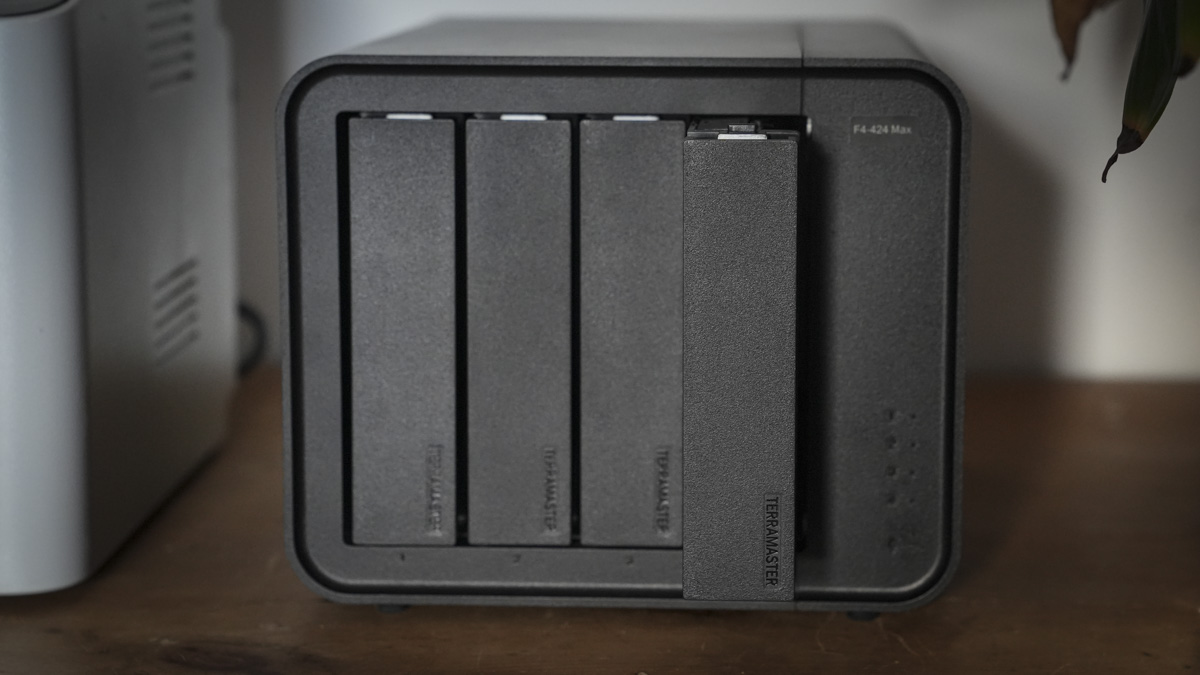
CPU: Intel Core i5-1235U
Graphics: Intel Iris Xe Graphics
RAM: 8 GB DDR5 non-ECC SODIMM (64 GB DDR5 non-ECC SODIMM)
Storage: 88 TB (22 TB x4) (Capacity may vary by RAID types), 2 (PCIe 4.0 x4)
Rear Ports: Type A *2 (10 Gbps); Type C *1 (10 Gbps), (HDMI 2.0), 2 x 10GbE Ethernet ports
Connectivity: 2 x 10GbE Ethernet ports
Size: 223 x 180 x 147mm
OS installed: TOS 6
Accessories: Network cable, AC power cord
The TerraMaster F4-424 Max is a network-attached storage unit designed for both the home office and small businesses. Out of the box, it offers an extremely powerful and versatile NAS option in a very simple-to-use and straightforward format that’s highly configurable to your needs.
Taking the unit out of the box, the size and weight mean it can be easily placed on a desktop and doesn’t need to be hidden away in a network cupboard. The configuration is also extremely easy to work out, with four main drive bays at the front with quick-release lever access that enables you to mount your selection of drives with various capacities and speeds. Then, removing the side panel, secured with two screws, two ultra-fast NVMe M.2 SSD slots are revealed, as well as the upgradable dual channel RAM.
Whilst the box, at nearly $900 (£900), is expensive, considering what the barebones unit actually offers, it’s a completely scalable solution. If you are working at home, you’ll find this NAS system is easy to set up and ideal for storing all of your home documents and work, utilising a safe RAID system that’s accessible through the local area network. Likewise, in a small business with multiple users, the system can be expanded to cope with the additional storage and processing needs.
What the TerraMaster F4-424 manages to do is get over the biggest stumbling block that I’ve found with even some of the best NAS devices, and that’s ease of use. Most small businesses don’t have 24-hour IT support or the technical know-how to set up and administer a decent NAS system properly. However, here, TerraMaster offers this from the outset, with online support and guides that make it easy for anyone with no prior experience to get started. Everything from installing the drives and running the initial setup using the browser-based TOS 6 OS really isn’t difficult.
Essentially, through the setup once the four drives are installed and two NVMe drives, you can then connect, with network cables, the system to your network through your network hub. Type in the NAS IP into the browser, and the TOS 6 OS will appear, walking you step-by-step through the initial setup process. Once that’s done, you can click on Storage and set up your storage volumes. After that, click on the File Manager, and you can add public folders and access rights to those folders. As the TOS OS is widely used, there’s plenty of information out there if you do get stuck, but really, it is very simple to use, and there’s always official online support if you need it. What this essentially means is that if you’ve got no prior experience, this F4-424 Max box should be a great place to start.
If you’re looking to use the F4-424 Max in a business location, you’ll be able to quickly access the drive content, along with other workers, to download files and access a fast central data storage resource. Through this test, I actually found that the transfer speeds were significant enough to quickly back up an 8K video to the internal storage. With those two fast NVMe drives, I had access to faster network storage than I used to, which enabled some network video editing, which was impressive.
Overall, I was impressed with the speed of setup and use. The F4-424 Max was incredibly easy to access from the network and multiple machines at the same time, and the actual transfer speed to access the internal storage was extremely quick using the default configuration. What I really like about this NAS solution is that it’s completely scalable. Whilst it’s at the upper end of the price bracket for a barebones system, it gives far more flexibility and capability than the cheaper solutions out there, making it ideal if you handle larger amounts of data or have a business that is expanding at speed.
TerraMaster F4-424 Max: Price & availability
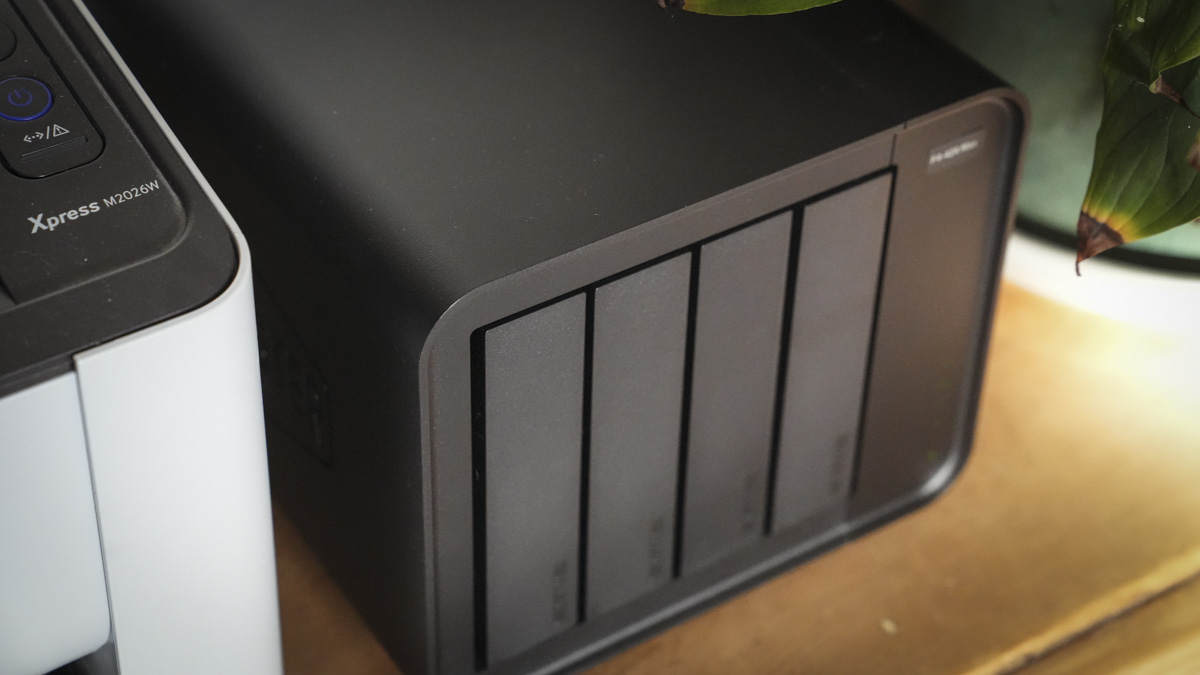
The TerraMaster F4-424 Max is widely available and can be purchased directly through the TerraMaster website at $899 / £819 by clicking here.
It’s also available through online retailers, including Amazon.
TerraMaster F4-424 Max: Design & build
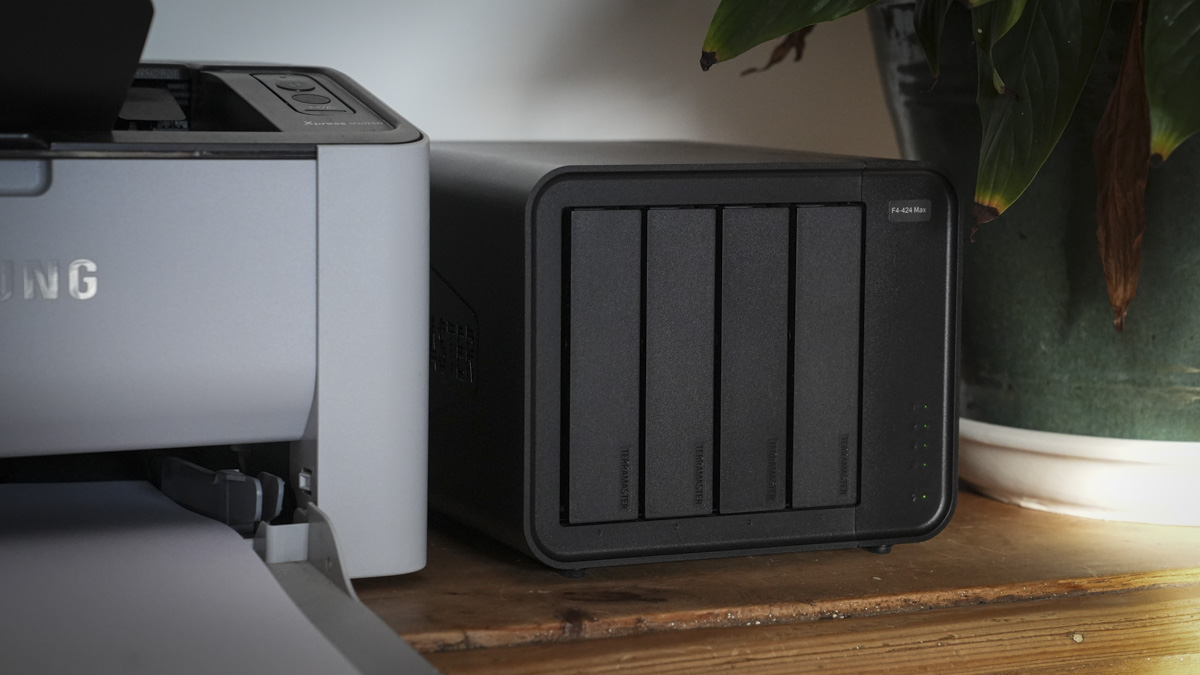
Traditionally, NAS boxes have had an industrial look and feel to them. For good reason—they’ve usually been designed to be used by IT specialists who know exactly what they’re doing, how to set them up, and how to grant access to users who need to access network storage. However, with more of us working from home, the usefulness of a network-attached drive is ever-increasing for several reasons.
Firstly, it gives you a way to store all your office and work files in one place that’s accessible from any desktop, mobile device, or tablet within your home or small office. If you set up the permissions correctly, you can also access the drive remotely. This means if you need to go into the office or access files while away, that’s perfectly possible. This box has been designed to offer all that flexibility in an easy-to-use solution, typically expected only from much higher-end NAS units.
The design resembles a large-scale desktop hard drive, with sleek, slightly rounded edges, an all-black metal and plastic construction, and a matte black finish. It looks stylish, so if you want it displayed on your desktop, it won’t look out of place—far removed from the industrial NAS boxes of a few years ago.
Not only that, but the actual setup of the unit is extremely easy. You have the option to slot in up to four traditional hard drives of up to 22TB each into the four lever-lock caddies at the front of the unit. Essentially, you push the lever in and pull the caddy out, then bolt each HDD in place, slot it back in, and repeat until all four slots are filled. This is usually where most smaller NAS systems end, but here TerraMaster has included a further option. Once two screws are removed from the back, the side of the unit can be pushed forward, revealing two NVMe M.2 SSD slots along with dual-channel RAM slots.
The RAM slots can support up to 64GB, using two 32GB sticks. As it comes, the unit includes 8GB, which for most people will be more than enough for general office admin, storage, and use. However, if you’re thinking about using this as a media server, uploading and downloading larger files, or running applications directly from the box, you might want to consider upgrading. An additional 16GB to 32GB should suffice, or 64GB if your budget allows and you’re considering network video editing.
When it comes to NVMe M.2 storage, this can be upgraded to 4TB using 2TB sticks in each slot. What this enables, combined with the dual 10GbE Ethernet ports, is incredibly fast transfer speeds.
Once you’ve slotted in the HDDs (which can be either 3.5-inch SATA, 2.5-inch SATA with a caddy, purchased separately, or 2.5-inch SATA SSDs) alongside the NVMe drives (if you choose to install them), you can boot up the system and proceed with the setup process.
TerraMaster F4-424 Max: Features
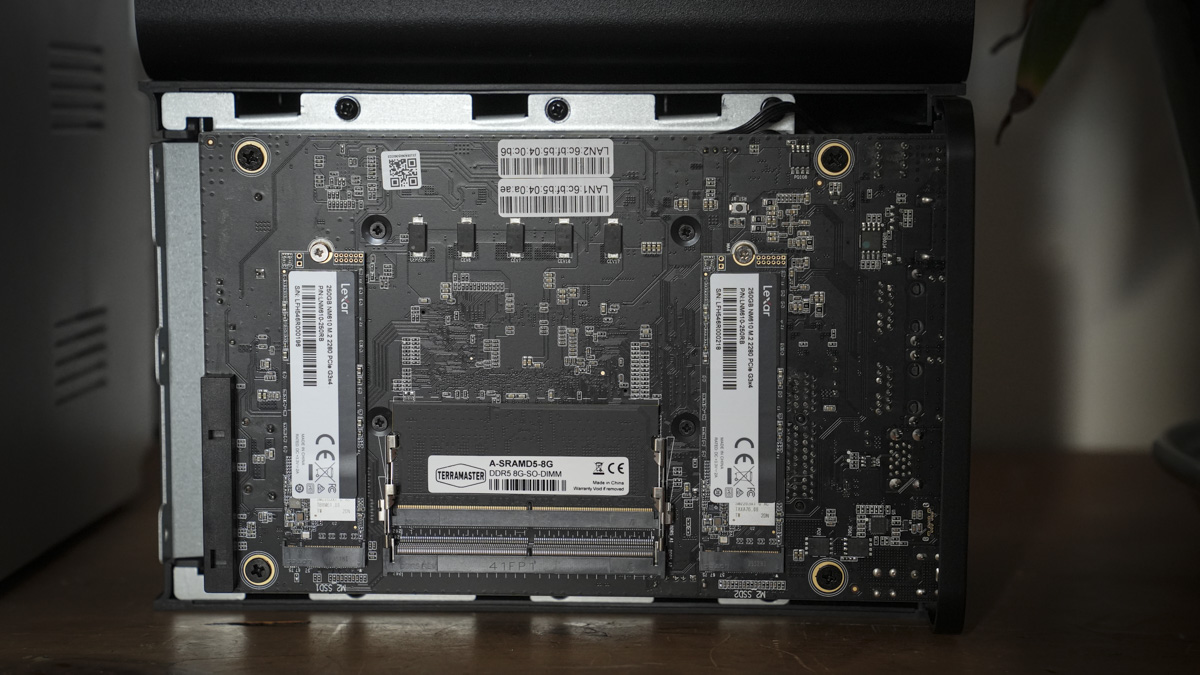
Considering the size of the F4-424 Max, this four-bay hybrid NAS has plenty of power on offer, which is immediately apparent as soon as you start to look through the specifications. First of all, there’s the Intel Core i5 processor with 10 cores and 12 threads. What’s more, it also includes Intel Iris Xe integrated graphics, which means that if you need to access the base code of the NAS for more advanced features, you can connect it directly to a monitor through the HDMI 2.0 port. There are also two USB Type-A ports on the back, which can be used to attach a keyboard and mouse for direct input. However, these ports can also be used to connect external storage if you want to boost the system’s capacity further.
When it comes to the four bays, you have standard 3.5-inch HDD slots, and with a caddy, you can also add 2.5-inch HDDs or SSDs. What’s more, alongside these four standard bays, there are two NVMe M.2 slots for faster storage. What’s interesting here is that while there is plenty of storage capacity, TerraMaster has ensured there is sufficient airflow through the system. Even during high-capacity transfers, the noise generated by the internal cooling remains relatively low, with a quoted 21 dB of noise.
For network connectivity, this is a wired-only system with two 10GbE LAN ports on the back, allowing you to connect to your local area network easily. If you are using a simple home wireless hub, you might need to purchase an additional network LAN hub for more port options. However, many wireless routers already have several LAN ports you can plug directly into. These LAN ports use the SMB multichannel technology, so if you use both with compatible equipment, you can achieve speeds of up to 20GbE.
The operating system that powers this NAS relies on the latest TOS 6 OS, which has a proven track record and has been used in many of TerraMaster’s other network-attached storage solutions. On the surface, it’s relatively simple, and if you’re a complete novice to network storage drives, it won’t take too long to figure out. TerraMaster also provides plenty of online support videos and documentation to guide you through the setup process.
One of the main uses for NAS systems within the home and small office is as a media hub. With the Intel Core i5 processor, you have 4K video decoding built-in, supporting Plex, Emby, and Jellyfin. This makes it perfectly possible to use as a home media server. Again, a slight boost in RAM might be a worthwhile investment if you do intend to use it in this way.
Additionally, it’s fully compatible with the Btrfs file system, so if you want to use it as a fully-fledged server, you can. Again, adding more RAM will make a difference to the performance.
For RAID options (essentially how the internal hard drives are configured for storage), the F4-424 supports both RAID 5 and TRAID. This gives you flexibility over how you configure the drives and allocate space. As standard TerraMaster has also incorporated a few additional software extras, including Terra Photos, which offers intelligent photo management, allowing you to tag and organise your images easily. This makes the NAS a great solution for enthusiasts and professional photographers who are looking for an easy-to-use media server to organise their images.
As with any storage device used for business, you’ll want to ensure everything is safe and secure. One of the benefits of a NAS system is that the RAID configuration ensures your data is spread across multiple drives. If one drive fails, the data can still be recovered from the remaining drives after inserting a new one. Alongside standard RAID configurations, you also have multiple other security protection measures, all accessible through the TOS 6 OS interface.
As an example of these additional security features, there are the business backup solutions, such as complete backups to another TerraMaster NAS device locally or the ability to transfer the files to another NAS located elsewhere. You can also utilise Windows SMB backup systems and other cloud recovery options, all enabling plenty of flexibility to suit your needs.
While most users will utilise the TOS 6 OS and App for standard NAS storage, with the processor and power, you can also utilise the F4-424 as a Windows server, physical server, file server, or virtual machine; this flexibility really does differentiate it from many other out-of-the-box solutions.
When it comes to connection speeds, the two 10GbE copper Ethernet ports support up to 20Gbps in bandwidth for data transmission. As previously covered, this uses SMB multichannel technology to utilise both ports, and when done, the F4-424 Max can deliver linear write speeds of up to 2090MB/s and 4K random read/write speeds of up to 400MB/s. This makes it suitable for image and video editing—something few other systems of this size or price can offer.
As mentioned earlier, the built-in video decoding makes it a great option for anyone looking for a multimedia server to run Plex or similar apps. Beyond multimedia, the TOS 6 OS features an apps section where you can download and install a variety of other Apps onto the system, so if you need a music server, home security or webserver, it’s all possible. There’s also the TerraSync software, which allows you to synchronise your computers with the NAS as a full backup system.
Backup is one of the major features here for security and enables you to recover data. If you lose or damage your laptop or other devices; your data is safely backed up. Additionally, there’s CloudSync, which streamlines workflows with direct connections to Google Drive, OneDrive, Amazon S3, Dropbox, Baidu, and Alibaba Cloud.
Though it looks simple on the outside, the F4-424 Max offers a huge amount of features considering the price. The great thing about this NAS solution is that you can completely tailor it with the storage and applications you need to suit your business or home office needs.
TerraMaster F4-424 Max: Performance
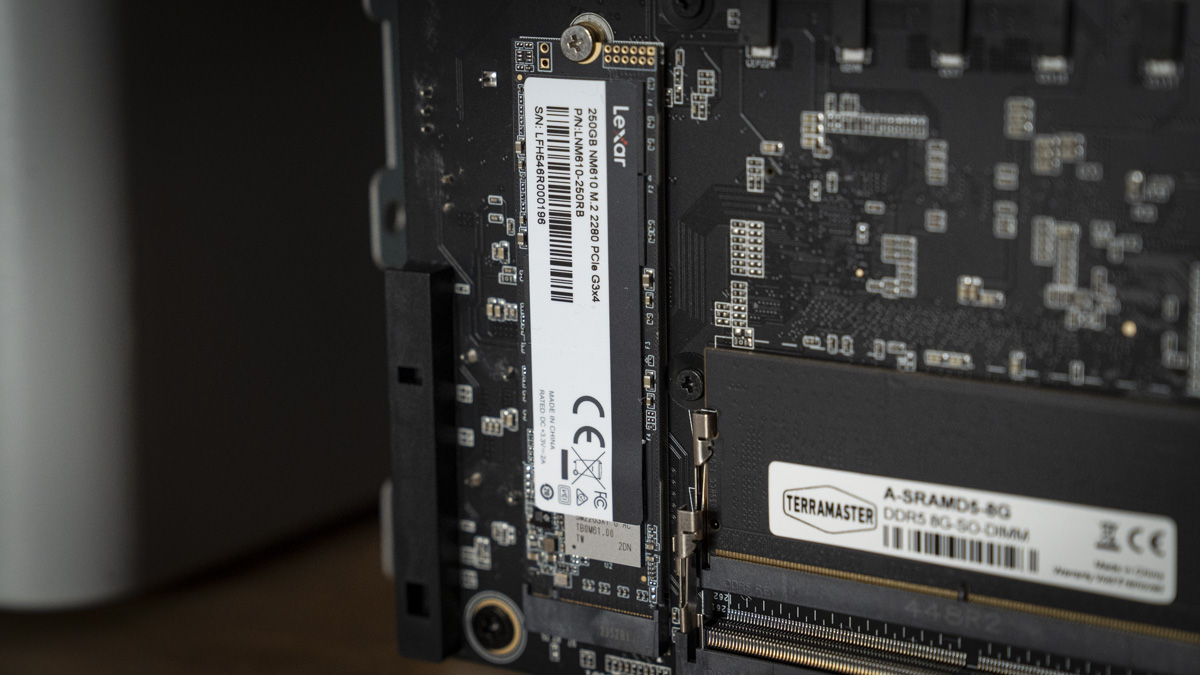
Starting with the F4-424 Max and lifting it from the box, it’s instantly apparent that TerraMaster has focused on ease of use with this NAS system. Much of the complexity of older NAS boxes is gone. From the outset, installing the four Lexar 2.5-inch SSDs into 3.5-inch caddies (bought separately) and then installing those into the NAS was extremely easy. The process for the four bays is as simple as it gets, with a quick access lever allowing the caddy to be pulled straight out of the front of the machine and reinstalled quickly as needed. This means that upgrading storage or replacing a drive can be done within a couple of minutes, rather than having to undo a load of bolts to access the drives.
While this feature isn’t uncommon in professional NAS systems, until recently, it wasn’t so common with small and home office solutions, although it’s becoming more common.
While the main four bays at the front are easily accessible, there’s also the option to add two NVMe drives on the side of the machine. To access these slots, you need to remove two screws at the back of the machine, then push the side of the case to remove it to reveal. These slots are essentially the same as you’d find in most PCs, allowing you to quickly install two NVMe sticks (up to 2TB each) and bolt them back in. Between these two slots are the dual-channel RAM slots. If you want to upgrade the RAM at the same time, you can. The unit comes with 8GB as standard, which was more than enough for most tasks during testing. However, if you want to achieve faster transfer speeds or perform video editing, upgrading to at least 16GB is worthwhile, and 64GB is absolutely ideal.
Once the four drives are installed in the front and the two NVMe drives are installed on the side, everything can be reassembled, plugged in, and switched on. As we’ve seen with other TerraMaster drives, the initial setup process using the TOS 6 OS is fast and straightforward. TerraMaster provides clear, step-by-step guides to the setup process, allowing you to configure the drives into volumes in whichever way suits your needs.
For this test, I opted for mass storage (Lexar NS100 SSDs) on the four main drives and fast access storage on the two NVMe (Lexar NM610 NVMe) drives. Through the OS, I was able to quickly set up two volumes: the first combining the storage of the four main drives into one volume, and the second using the NVMe drives. I then allocated folders to the main volume, creating folders for video, documents, and other media. I also set up a PLEX account and installed apps for media playback.
On the NVMe fast-access drives, I created a new volume. While the NVMe drives I used were relatively small, they were sufficient for quick HD and 4K video editing. Although my network setup didn’t allow me to access the fastest transfer rates this box is capable of, it provided a solid test of its capabilities.
The rest of the F4-424 setup, including app installations and its use through the browser interface, was fast and easy. If you have a Plex account, then you can log in and access it from any web-enabled device in the office or home. What’s great about Plex is that you can save all your movies to internal storage, eliminating reliance on streaming services and providing a way to keep your video library organised. Similarly, you can add your music and images through the Terra Photos app, which includes tools to help you stay organised. While these Apps are designed for home use, they’re also a great way to keep your media assets organised and accessible.
For use in a home office or small office, the F4-424 Max is an excellent solution. One of the tests I conducted was to see how the NAS box would perform with multiple connections. I connected two PCs and two Macs, all accessing content from the NAS box simultaneously. There were very few, if any, issues. One of the machines was accessing content via a wireless connection, while the others were connected through a wired network.
For those on a wireless connection, the average transfer rate was around 100–150MB/s. With multiple connections, this dropped to around 80–100MB/s, which was still impressive. Likewise, due to Network limitations, the wired connection topped out at around 150MB/s.
Overall, from the initial setup through to the use of the TOS 6 OS and its applications, the TerraMaster F4-424 Max is an exceptionally well-thought-out NAS system that is perfect for any small or home office. Its scalability and flexibility make it a superb option if you’re looking for a secure and reliable storage solution that is network-accessible from any location.
Should you buy the TerraMaster F4-424 Max?
NAS systems like this can be tricky, especially for those without much IT experience. However, with the F4-424, TerraMaster has aimed to make what is essentially a complex device as simple as possible. The initial setup is relatively straightforward, and there shouldn’t be anything here that causes issues. During the review, it took me roughly 5 to 10 minutes to install the drives, plug everything in, and power it up.
One of the major considerations for anyone looking at a NAS drive instead of a standard desktop drive is understanding that a NAS drive must be accessed via a network. There’s no direct connection option—you can’t just plug it directly into your machine and expect to access those files.
The F4-424 simplifies this concept with its TOS 6 browser-based application. This software allows you to set up volumes quickly and easily, especially with the included guides. Once that’s done, you can assign a series of folders and get those mapped for access, and it even guides you on how to ensure those drives mount automatically every time you switch on your machine.
These drives will then appear as network drives, similar to what you might already be familiar with in a standard working environment. The ease of setup and maintenance makes this a fantastic option, especially for users with little to no IT experience.
There are many standout features of this NAS system, but for me—and anyone running a small business—the reassurance that your data is safe, secure, and spread across multiple drives is essential. The RAID configuration ensures that if one drive fails, it can be replaced without any loss of data. Additionally, the sync options enable your laptops and desktop machines to be backed up to the NAS drive. In turn, the NAS itself can be backed up to another drive or an online backup solution. The entire process can all be nicely integrated with the use of Apps, and TerraMaster provides guides to walk you through each step.
As a complete solution, the TerraMaster F4-424 is one of the best options I’ve seen. What truly gives it an edge are the two NVMe M.2 drives that slot into the side. While 4TB might seem like a significant amount of storage, video production can quickly consume that volume. However, if you have a fast network and utilise the SMB protocol and dual-channel LAN ports, you can use this as a network-attached editing storage solution. For any small production company that can’t quite afford to step up to pro-level network video options, this NAS offers an excellent starting point—something few other drives at this price point can match.
| Row 0 – Cell 0 | Row 0 – Cell 1 | Row 0 – Cell 2 |
| Value | While it may seem expensive, the flexibility and maximum storage capacity make it excellent value. | 5 |
| Design | Drives are easy to install, and with the two additional NVMe drives, it becomes an extremely versatile and well-designed option. | 4.5 |
| Features | At the base level, there’s enough to get small business owners started, with expansion options ensuring your investment lasts for years. | 5 |
| Performance | The base-level performance will suit most business owners, and additional RAM or storage can easily be added if needed. | 5 |
| Total | One of the best solutions I’ve reviewed at this price—ideal for content creators and small businesses alike. | 5 |
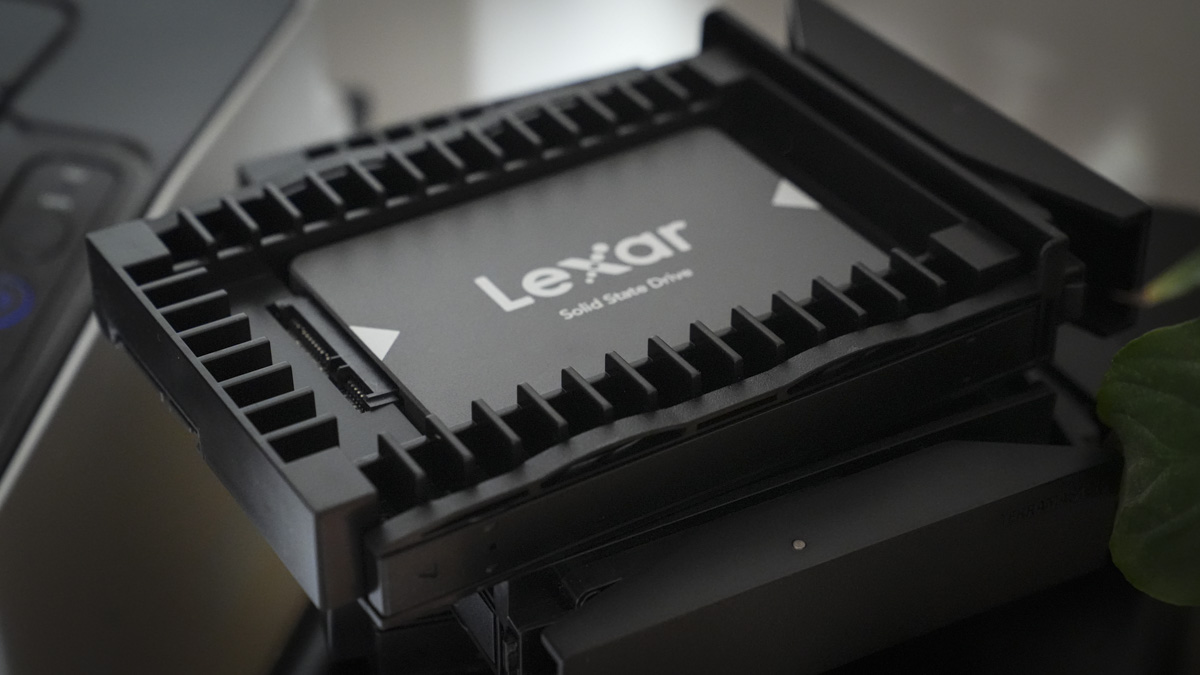
Buy it if…
Don’t buy it if…
For more network-attached storage options, we’ve also tested the best NAS & media server distro.

